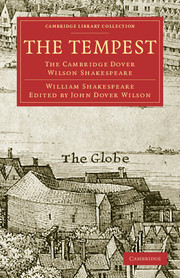THE COPY USED FOR THE TEMPEST
Published online by Cambridge University Press: 07 September 2010
Summary
There is no Quarto for The Tempest; and there seems good reason to suppose that the ‘copy’ for the Folio text was author's manuscript which had served as prompt-copy in the theatre. Prompt-copy in that age, however, might have a long history; and the condition of the Folio text appears to show that the Tempest MS had seen many changes before it reached the printer's hands. Something of the character of these changes may be gathered from a consideration of the following points:
(i) The traces of rhymed couplets at 3.1.24–5,29–30; 3. 3. 32–3, 49–51, and elsewhere, together with the doggerel at 3. 2. 77–8 suggest that when Shakespeare took up The Tempest late in his career he had an old manuscript to go upon, possibly an early play of his own, which may have been related to the original of Die Schöne Sidea, a sixteenth century German drama with a kindred them.
(ii) The received text has been clearly abridged, and abridged in the main by Shakespeare himself. The signs of this abridgment are many. The Tempest is the shortest text but one in the canon. Broken lines abound in it, as do passages of incorrect verse-lining—a sure sign of marginal alteration in a good text. The unsystematic mingling of verse and prose, e.g. in the wreck-scene and the Stephano scenes, point to the same conclusion, as also do characters like Antonio's son, who is referred to as being in the wreck but does not appear on the island, Francisco who appears, though seemingly by accident rather than design, and Trinculo who, though styled a ‘jester’ in the Folio ‘names of the actors,’ does very little to support this title, except to be called ‘patch’ and ‘pied ninny’ at one point.
Information
- Type
- Chapter
- Information
- The TempestThe Cambridge Dover Wilson Shakespeare, pp. 79 - 86Publisher: Cambridge University PressPrint publication year: 2009First published in: 1921
